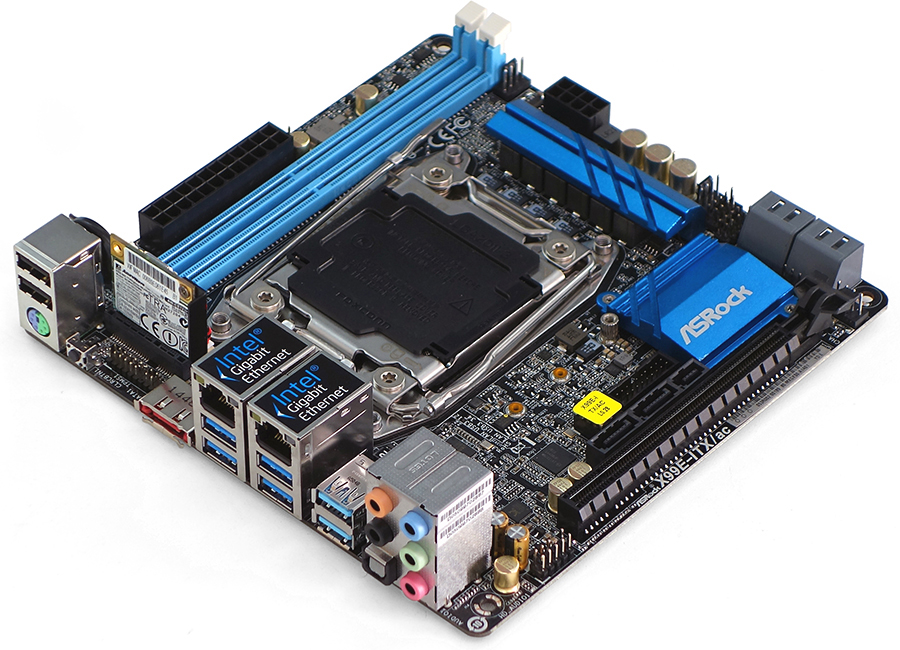Early Verdict
The X99E-ITX/ac combines the compactness of Mini ITX with the computing prowess of a Haswell-E CPU. A two-DIMM limit that seems restrictive by X99 standards is standard in Mini ITX, and our benchmark prove that more bandwidth is rarely needed. Being both a good overall product and an exclusive in its class, the X99E-ITX/ac wins our Best In Class “Choice” award.
Pros
- +
802.11ac Wi-Fi
- +
Dual Gigabit Ethernet
- +
Form Factor
- +
Price
- +
USB 3.1
Cons
- -
Cooler
- -
Cooler mounting pattern
Why you can trust Tom's Hardware
Introduction
ASRock announced its exclusive mini-ITX coverage for the LGA 2011-v3 platform with much praise and panning from the enthusiast community, a large portion of which didn’t see the point of pairing a 40-lane (or 28-lane) PCIe 3.0 controller with a single expansion slot. Among those who understood its usefulness, there were still those who felt that two memory slots might be a little too limiting for the CPU’s quad-channel controller. But if we look at this another way, we see an LGA 1150 alternative with up to twice as many active cores. And that can only be a good thing, right?
A quick look at the overall picture shows a board with all the high-end mini-ITX prerequisites, from dual gigabit Ethernet controllers to a true dual-band 802.11ac (867 Mb/s) controller with integrated Bluetooth, which we as PC enthusiasts know is far more than an interface for your hands-free kit. It even has an eSATA port. But what’s with the two teal USB ports? ASRock found a use for a couple of the chipset’s spare PCIe 2.0 lanes, adding ASMedia's ASM1142 USB 3.1 controller. Two more lanes connect the PCIe portion of the SATA Express connector, leaving a few lanes untapped to reduce DMI bandwidth.
The CPU’s leftover PCIe 3.0 lanes aren’t completely wasted either, as the X99E-ITX/ac connects four of them to an M.2 slot. The trip gets a little stranger at this point because, according to Device Manager in Windows, the secondary network controller is connected to the CPU’s PCIe 3.0 pathway. We’ve heard that Haswell-E processors can support up to five devices, and connecting this to the CPU does free up some of the chipset’s DMI bandwidth, even though the network controller doesn’t benefit from PCIe 3.0.
Before we dig any deeper into the details, here’s how the X99E-ITX/ac compares to the microATX motherboards we’ve reviewed:
Get Tom's Hardware's best news and in-depth reviews, straight to your inbox.
-
Crashman Reply
Sorry, I don't have any DDR4 SODIMMs yet.15937166 said:How about a test of the ASRock EPC612D4I. It has four memory slots.
-
uglyduckling81 Is it just me or does the lets compare to other boards bit not contain any other boards to to compare against?Reply -
wtfxxxgp ReplyIs it just me or does the lets compare to other boards bit not contain any other boards to to compare against?
True. However, that section is pointless as it has no direct rivals - I think they're using a standard template and they had to fill something in there. -
apache_lives For that socket/platform its almost a complete waste - all those unusable memory channels and pcie lanes that make the 2011 platform high end have been stripped awayReply -
Crashman Reply
it's really just for people who want more cores. So, feel free to ridicule anyone who tries to pair it with an E5-1620 :p15937458 said:For that socket/platform its almost a complete waste - all those unusable memory channels and pcie lanes that make the 2011 platform high end have been stripped away -
Daniel Ladishew Testing this on the stock cooler is useful information, but this mobo will only shine when water cooled. I'd like to see the tests repeated with a closed loop cooler attached. Either the Cooler Master or Corsair H100 (which i've heard will work with that bracket as well). If the point is to pack lots of cores into a small form factor, not overcoming the thermal throttling seems like a weak test.Reply -
TechyInAZ While not as good as it's micro atx counterparts (obviously), I am very impressed by this motherboard.Reply
So if somebody that doesn't need all the PCIE lanes or memory lanes but just the pure power of a hexa/octo core CPU in a small package, then this is the best solution. -
goinginstyle So other X99 boards get ripped for not being able to do 4-way SLI or 3-way with a PCIe RAID controller but this one gets a pass on those items plus numerous others (lower OC, lack of memory expansion, high price, etc) and receives an award. The board reviews here are just becoming a joke.Reply

